Research on the Location and Capacity Determination Strategy of Off-Grid Wind–Solar Storage Charging Stations Based on Path Demand
Abstract
:1. Introduction
2. EV Charging Station Site Planning
2.1. Electric Vehicle Model
2.2. Traffic Flow Model
2.3. Site Selection Planning Model
- (1)
- The electric vehicles considered in this model are based on the four types proposed in Section 2.1, where the electric vehicle battery capacity follows the corresponding probability distribution, and there is a correlation between the maximum range and battery capacity.
- (2)
- The driving distance of electric vehicles is linearly related to the battery level. Vehicles always travel via the shortest path without considering detours or traffic congestion.
- (3)
- Regarding the charging station selection strategy, in alignment with real-world driver decisions, when a vehicle’s remaining battery level falls below 30% and it can reach the next charging station i, it will inevitably choose to charge at station i. When the vehicle passes through charging station j with a battery level above 30% but insufficient to reach the next station k, it will opt to charge at station j.
- (4)
- Cars use DC fast charging on highways. According to the relevant literature, charging times are faster between 20% and 80% battery levels, with charging time after 80% accounting for over 50% of the total time. Considering charging duration and driver range anxiety, cars are assumed to have a battery level between 80% and 90% after charging at the station. Type L vehicles with smaller battery capacities depart from the charging station with a full battery after charging.
2.4. Solution Process
3. EV Charging Station Capacity Planning
3.1. System Structure
3.2. Construction of Source Load Storage Temporal Scenarios
3.2.1. Wind Power Generation Model
3.2.2. Solar Power Generation Model
3.2.3. Energy Storage Model
3.2.4. Diesel Generator Model
3.3. Partitioning of Typical Wind–Solar Power Output Scenarios Using Enhanced K-Means Clustering
3.4. Wind–Solar Storage Charging Station Model
3.4.1. Objective Function
3.4.2. Constraints
4. Arithmetic Simulation
4.1. Basic Parameters
4.2. Site Planning Results
4.3. Capacity Planning Results
4.4. Comparative Analysis of Various Configuration Plans
4.5. Comparative Analysis of Configuration Schemes Based on Different Site Selection Results
4.6. Comparative Analysis of Site Selection and Capacity Planning Strategies for Different Numbers of Vehicles
4.7. Sensitivity Analysis
4.7.1. The Influence of Varying Proportions of Vehicle Types on the Experimental Outcomes
4.7.2. Impact of Diesel Generator Pollution Control Costs on Capacity Allocation Results
4.7.3. Influence of Factor Weights on Capacity Configuration Outcomes
4.8. Contrasting Model Solution Strategies
4.9. Charging Tariffs and Positive Revenue of Charging Stations
5. Conclusions
Author Contributions
Funding
Data Availability Statement
Conflicts of Interest
References
- Lu, Q.; Duan, H.; Shi, H.; Peng, B.; Liu, Y.; Wu, T.; Du, H.; Wang, S. Decarbonization Scenarios and Carbon Reduction Potential for China’s Road Transportation by 2060. NPJ Urban Sustain. 2022, 2, 1–9. [Google Scholar] [CrossRef]
- Relevant Responsible Comrades of the National Development and Reform Commission and the National Energy Administration Answered Reporters’ Questions on the “14th Five-Year Plan for Renewable energy Development”. Available online: https://www.nea.gov.cn/2022-06/01/c_1310611147.htm (accessed on 1 June 2024).
- Dong, X.; Mu, Y.; Jia, H.; Wu, J.; Yu, X. Planning of Fast EV Charging Stations on a Round Freeway. IEEE Trans. Sustain. Energy 2016, 7, 1452–1461. [Google Scholar] [CrossRef]
- Jia, L.; Hu, Z.; Song, Y.; Zhan, K.; Ding, H. Planning of Electric Vehicle Charging Stations in Highway Network. Autom. Electr. Power Syst. 2015, 39, 82–89, 102. [Google Scholar]
- Zhao, F.; Li, J.; Gao, F. Siting and sizing of photovoltaic-storage charging stations on highway considering uncertainties. Electr. Power Autom. Equip. 2021, 41, 111–117. [Google Scholar]
- de Quevedo, P.M.; Muñoz-Delgado, G.; Contreras, J. Impact of Electric Vehicles on the Expansion Planning of Distribution Systems Considering Renewable Energy, Storage, and Charging Stations. IEEE Trans. Smart Grid 2019, 10, 794–804. [Google Scholar] [CrossRef]
- Ding, Z.; Lu, Y.; Zhang, L.; Lee, W.-J.; Chen, D. A Stochastic Resource-Planning Scheme for PHEV Charging Station Considering Energy Portfolio Optimization and Price-Responsive Demand. IEEE Trans. Ind. Appl. 2018, 54, 5590–5598. [Google Scholar] [CrossRef]
- Shaaban, M.F.; Mohamed, S.; Ismail, M.; Qaraqe, K.A.; Serpedin, E. Joint Planning of Smart EV Charging Stations and DGs in Eco-Friendly Remote Hybrid Microgrids. IEEE Trans. Smart Grid 2019, 10, 5819–5830. [Google Scholar] [CrossRef]
- Chen, Z.; Xiao, X.; Lu, X.; Liu, N.; Zhang, J. Multi-Objective Optimization for Capacity Configuration of PV-Based Electric Vehicle Charging Stations. Trans. China Electrotech. Soc. 2013, 28, 238–248. [Google Scholar]
- Chaudhari, K.; Ukil, A.; Kumar, K.N.; Manandhar, U.; Kollimalla, S.K. Hybrid Optimization for Economic Deployment of ESS in PV-Integrated EV Charging Stations. IEEE Trans. Ind. Inform. 2018, 14, 106–116. [Google Scholar] [CrossRef]
- Qian, K.; Zhou, C.; Allan, M.; Yuan, Y. Modeling of Load Demand Due to EV Battery Charging in Distribution Systems. IEEE Trans. Power Syst. 2011, 26, 802–810. [Google Scholar] [CrossRef]
- Mu, Y.; Wu, J.; Jenkins, N.; Jia, H.; Wang, C. A Spatial–Temporal Model for Grid Impact Analysis of Plug-in Electric Vehicles. Appl. Energy 2014, 114, 456–465. [Google Scholar] [CrossRef]
- Hu, S.-R.; Wang, C.-M. Vehicle Detector Deployment Strategies for the Estimation of Network Origin–Destination Demands Using Partial Link Traffic Counts. IEEE Trans. Intell. Transp. Syst. 2008, 9, 288–300. [Google Scholar]
- Liu, D.; Li, Z.; Jiang, J.; Cheng, X.; Wu, G. Electric Vehicle Load Forecast Based on Monte Carlo Algorithm. In Proceedings of the 2020 IEEE 9th Joint International Information Technology and Artificial Intelligence Conference (ITAIC), Chongqing, China, 11–13 December 2020; Volume 9, pp. 1760–1763. [Google Scholar]
- Kuby, M.; Lim, S. The Flow-Refueling Location Problem for Alternative-Fuel Vehicles. Socio-Econ. Plan. Sci. 2005, 39, 125–145. [Google Scholar] [CrossRef]
- Xie, R.; Wei, W.; Khodayar, M.E.; Wang, J.; Mei, S. Planning Fully Renewable Powered Charging Stations on Highways: A Data-Driven Robust Optimization Approach. IEEE Trans. Transp. Electrif. 2018, 4, 817–830. [Google Scholar] [CrossRef]
- Wu, J.; Liu, J.; Wu, Y. Coordinated Capacity Configuration Method of Source and Storage for Energy Self-sufficient System in Remote Areas. Power Syst. Technol. 2024, 48, 2031–2042. [Google Scholar]
- Masters, G.M. Renewable and Efficient Electric Power Systems; John Wiley & Sons Inc.: Hoboken, NJ, USA, 2004; pp. 385–443. [Google Scholar]
- Yan, Q.; Liu, Y.; Dong, X.; Ma, Y. Hybrid energy storage capacity optimization configuration for smoothing PV output based on CEEMDAN-HT. Power Syst. Prot. Control 2022, 50, 43–53. [Google Scholar]
- Zhou, Z.; Wang, C.; Jiao, B.; Guo, L.; Xu, W. Optimal Control of Wind/ Biomass/ Diesel/ Battery Stand-alone Microgrid System. Proc. CSEE 2015, 35, 3605–3615. [Google Scholar]
- Song, X.; Liu, Y. Wind and Photovoltaic Generation Scene Division Based on Improved K-means Clustering. Power Gener. Technol. 2020, 41, 625–630. [Google Scholar]
- Li, J. Research on Sizing and Siting of PV Storage Charging Integrated Stations on Expressways. Master’s Thesis, Lanzhou Jiaotong University, Lanzhou, China, 2022. [Google Scholar]
- Wang, X.; Tang, Z.; Fu, R. Optimal Confuguration for Stand-along Microgrid Capacity Based on Improved Operation Control Strategy. Water Resour. Power 2019, 37, 192–196. [Google Scholar]
- Li, Y.; Yang, Z.; Li, G.; Mu, Y.; Zhao, D.; Chen, C.; Shen, B. Optimal Scheduling of Isolated Microgrid with an Electric Vehicle Battery Swapping Station in Multi-Stakeholder Scenarios: A Bi-Level Programming Approach via Real-Time Pricing. Appl. Energy 2018, 232, 54–68. [Google Scholar] [CrossRef]
- Chen, H.; Guan, L.; Lu, C.; Li, Z.; Zhuo, Y. Multi-objective Optimal Dispatch Model and Its Algorithm in Isolated Microgrid with Renewable Energy Generation as Main Power Supply. Power Syst. Technol. 2020, 44, 664–674. [Google Scholar]
- Zhang, Y.; Jin, Y.; Ke, J.; Ru, F.; Zhang, C. Capacity configuration of microgrid in off-grid accessible service area considering variable load. J. Chang. Univ. (Nat. Sci. Ed.) 2024, 5, 126–140. [Google Scholar]
- Zhen, X.; Yao, Y. Multi-objective capacity allocation optimization method of photovoltaic EV charging station considering V2G. J. Cent. South Univ. 2021, 28, 481–493. [Google Scholar] [CrossRef]
- Wang, Y.; Yang, Y.; Zhang, N.; Huang, M. An Integrated Optimization Model of Charging Station/Battery-Swap Station/Energy Storage System Considering Uncertainty. In Proceedings of the 2017 IEEE International Conference on Energy Internet (ICEI), Beijing, China, 17–21 April 2017; pp. 77–82. [Google Scholar]
- Ghiaskar, A.; Amiri, A.; Mirjalili, S. Polar fox optimization algorithm: A novel meta-heuristic algorithm. Neural Comput. Appl. 2024, 36, 20983–21022. [Google Scholar] [CrossRef]
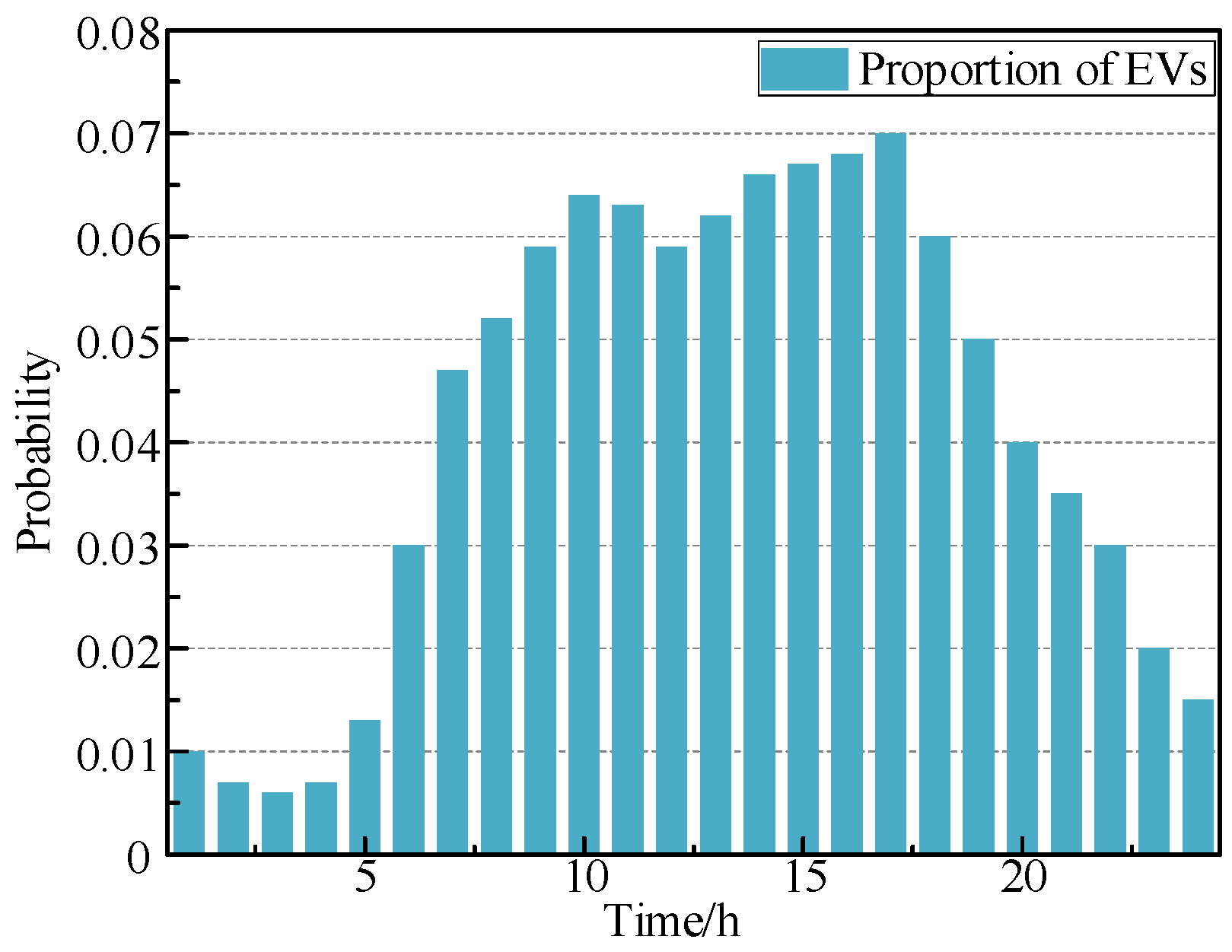




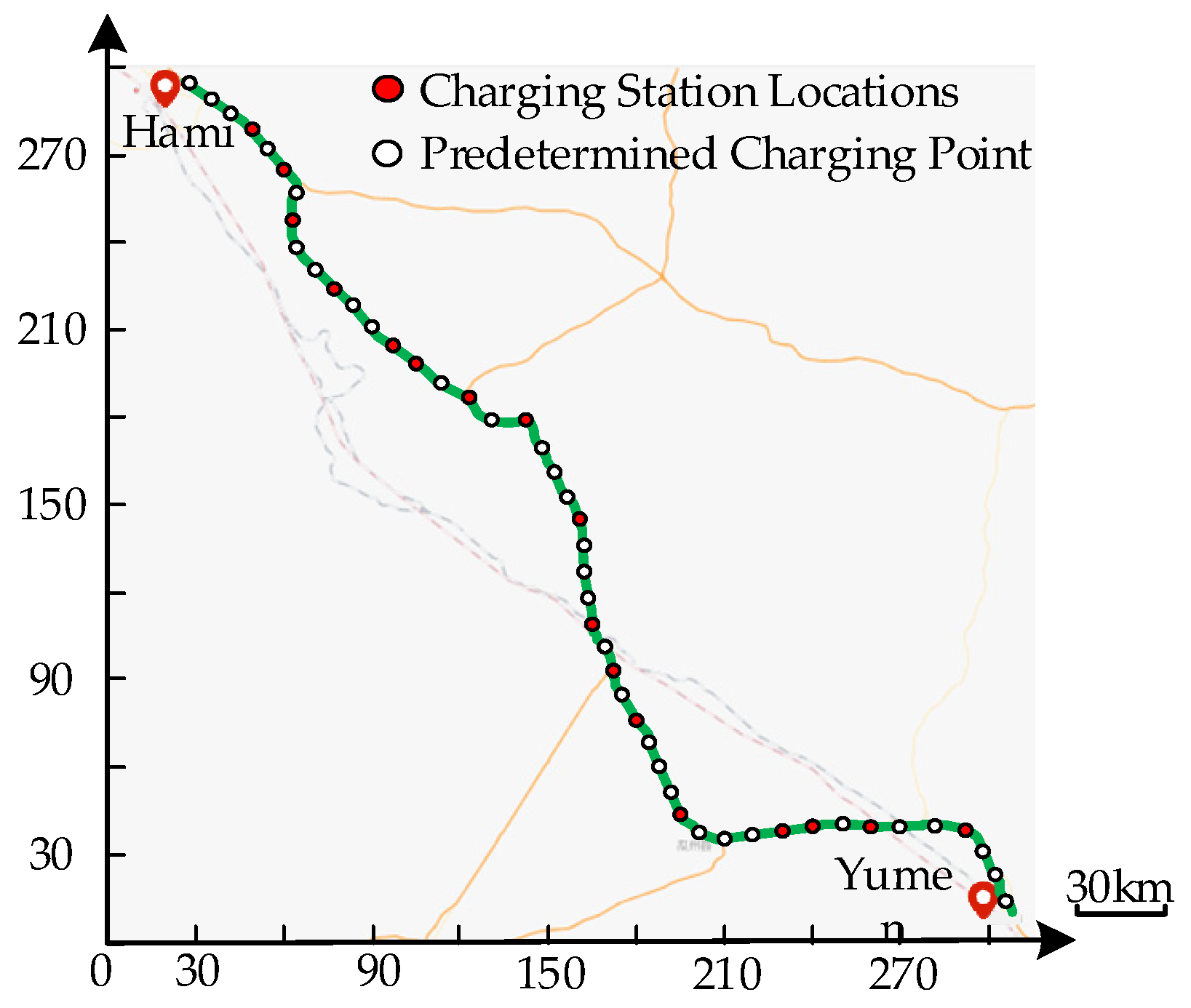
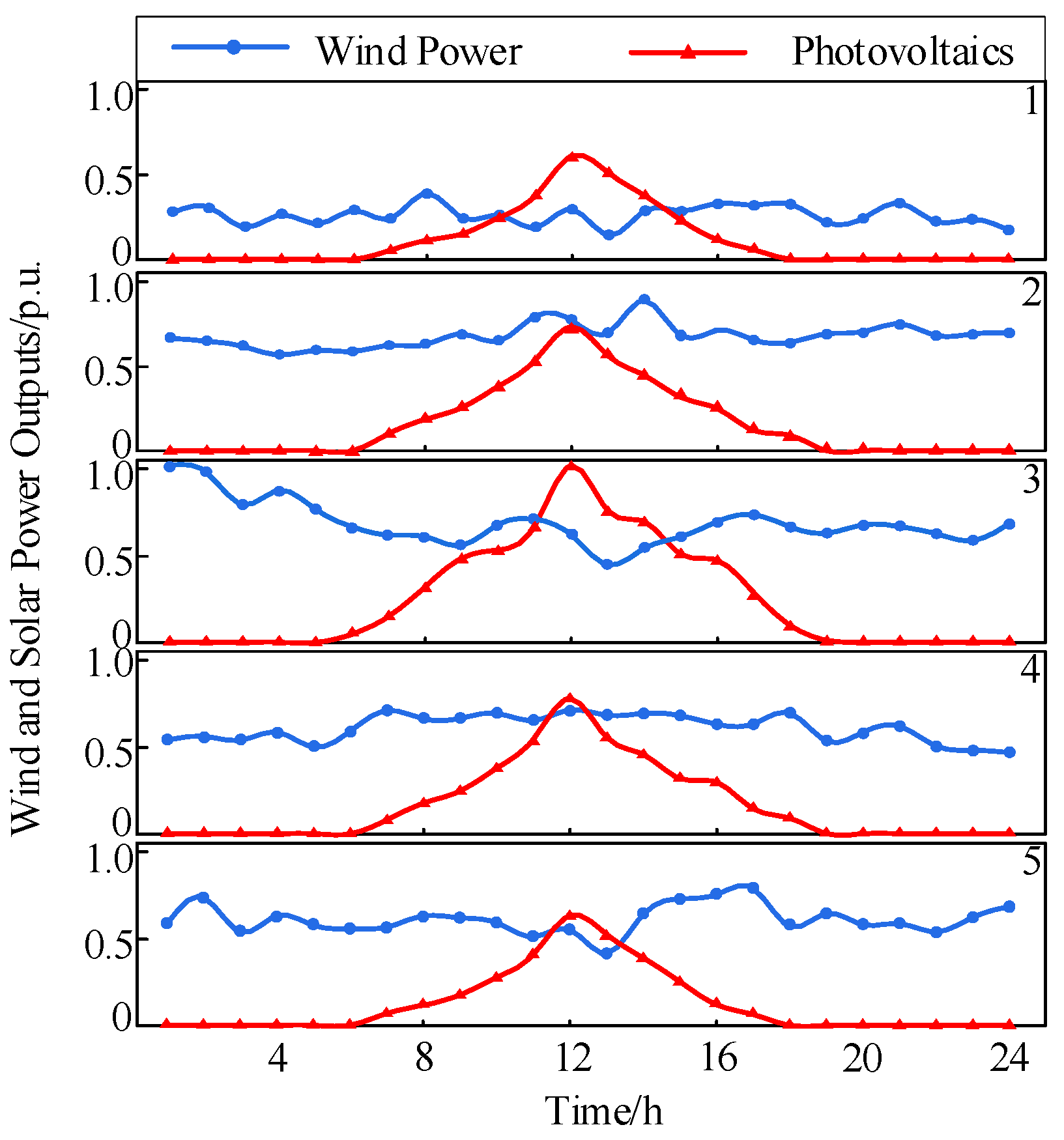

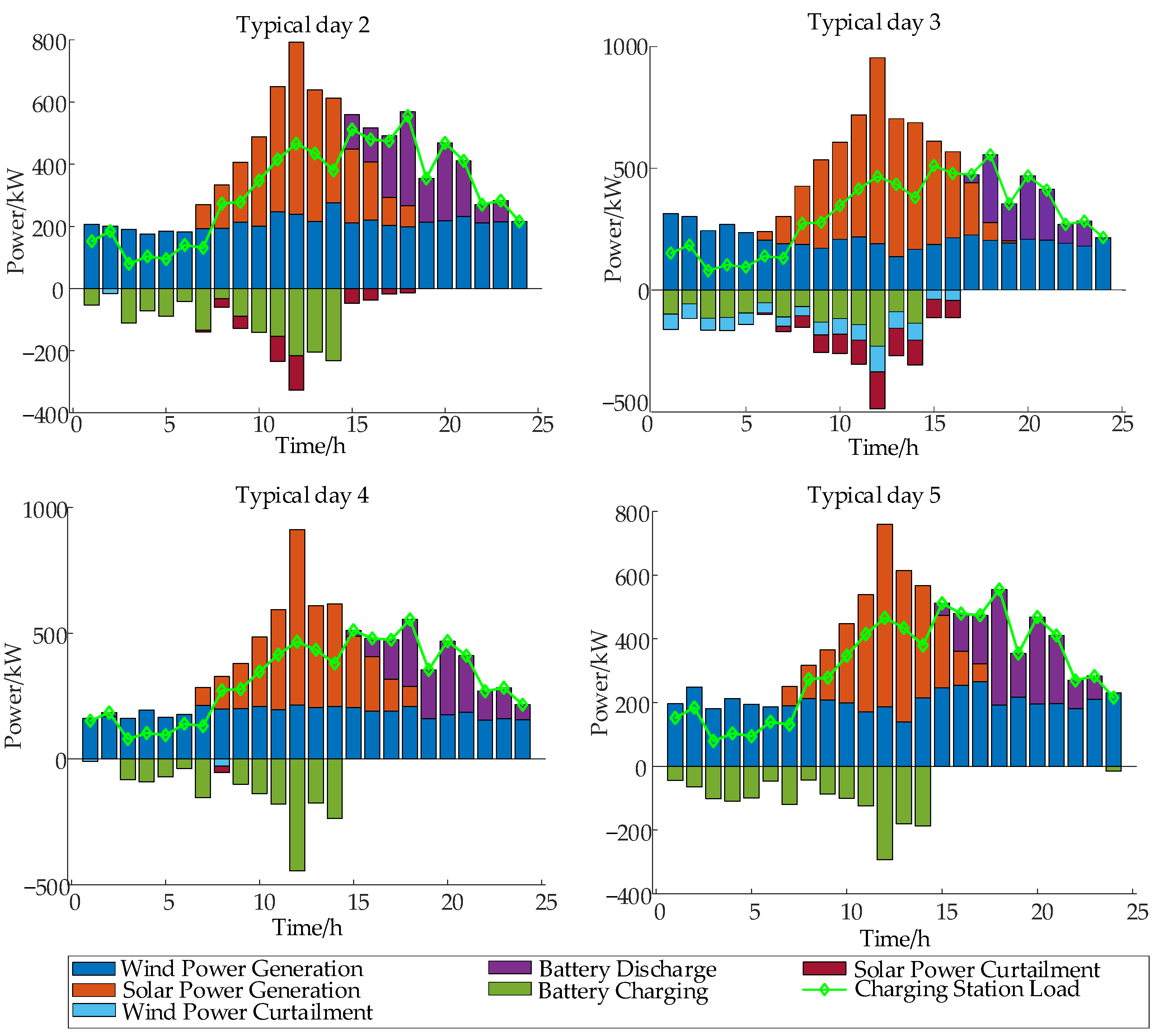
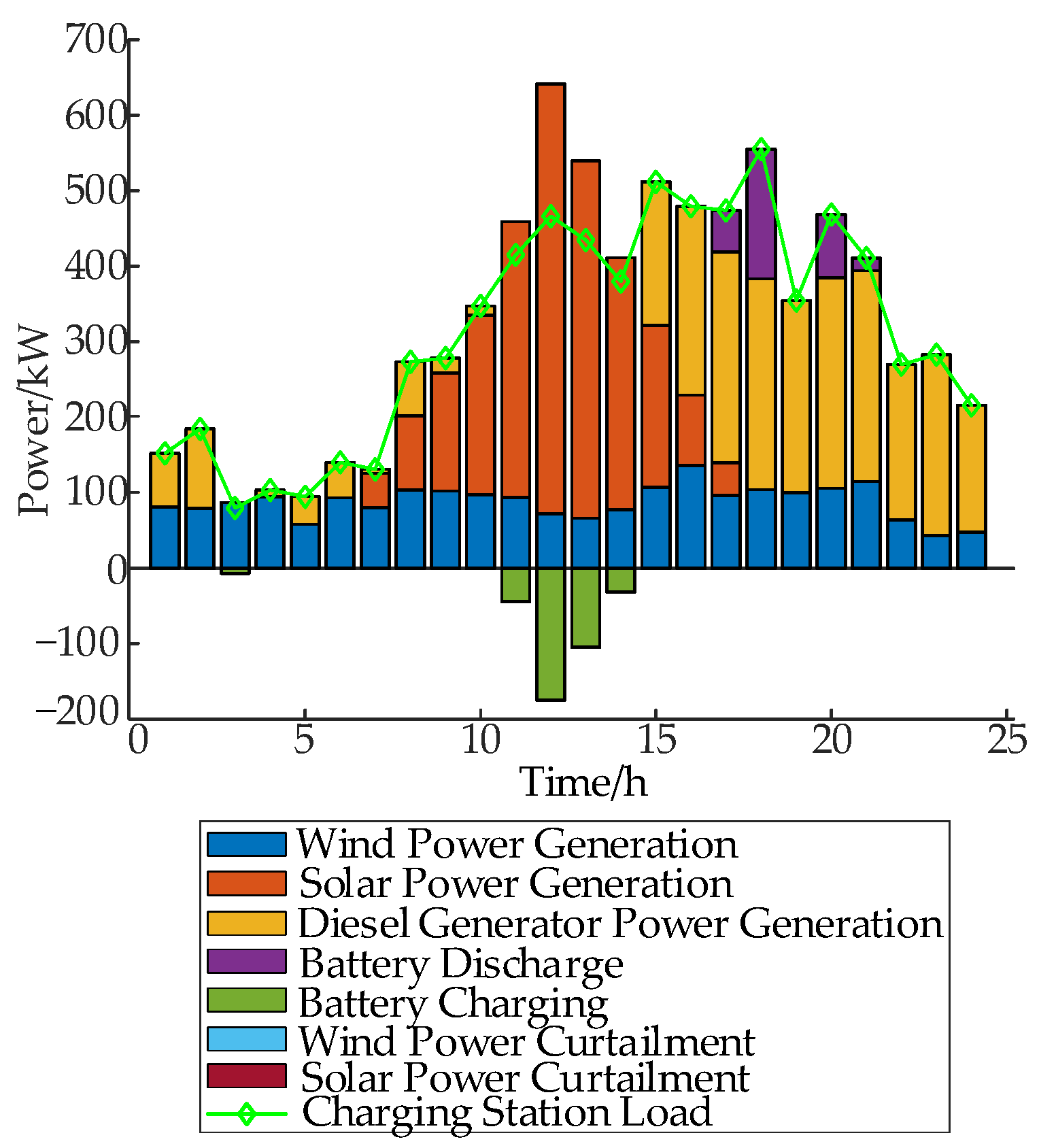
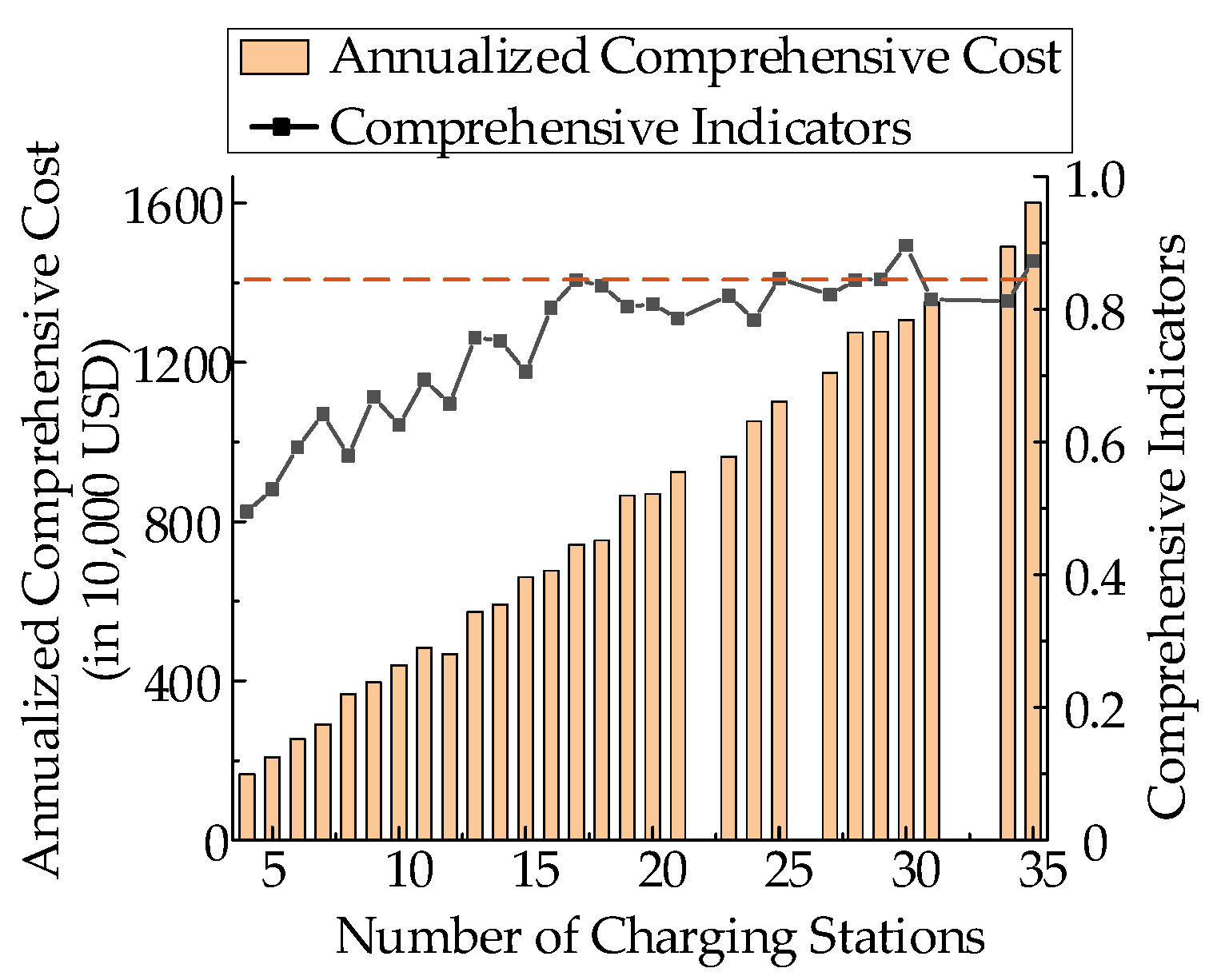


| EV Type | L | M | N1 | N2 |
|---|---|---|---|---|
| Distribution type | Gamma | Gamma | Normal | Normal |
| Parameter | μ1 = 10.8; δ1 = 0.8 | μ1 = 4.5; δ1 = 6.3 | μ2 = 23.0; δ2 = 9.5 | μ2 = 85.3; δ2 = 28.1 |
| Maximum (kW·h) | 15.0 | 72.0 | 40.0 | 120.0 |
| Minimum (kW·h) | 5.0 | 10.0 | 9.6 | 51.2 |
| Proportion | 10% | 84% | 3% | 3% |
| Parameters | Values | Unit |
|---|---|---|
| v | 90 | km·h−1 |
| SOCi | U(0.8, 0.9) | - |
| SOCC | U(0.15, 0.3) | - |
| W1 | 0.2 | kW·h/km |
| Pc | 50 | kW·h |
| η | 0.8 | - |
| Parameters | WT | PV | ES | G |
|---|---|---|---|---|
| Investment Cost (USD/kW) | 840 | 672 | 504 | 280 |
| Operation and Maintenance Cost (USD/kW) | 0.0098 | 0.0028 | 0.035 | 0.0084 |
| Service Life (year) | 15 | 20 | 10 | 15 |
| Discount Rate | 0.08 | 0.08 | 0.08 | 0.08 |
| Charging Station ID | Location (x,y) | Distance from Starting Point (km) | Daily Power Load (kWh) |
|---|---|---|---|
| 4 | (292.0, 38.1) | 41.50 | 5637.3 |
| 7 | (259.7, 39.1) | 72.62 | 11,408.3 |
| 9 | (239.9, 39.4) | 93.37 | 7603.1 |
| 10 | (229.7, 37.8) | 103.75 | 8348.7 |
| 14 | (195.0, 43.2) | 145.25 | 19,748.3 |
| 18 | (180.3, 75.5) | 186.75 | 9886.4 |
| 20 | (172.3, 92.4) | 207.50 | 11,585.3 |
| 22 | (165.4, 108.3) | 228.25 | 10,303.6 |
| 26 | (161.0, 144.4) | 269.74 | 19,342.5 |
| 30 | (142.7, 178.4) | 311.24 | 12,504.9 |
| 32 | (123.6, 186.2) | 331.99 | 8986.1 |
| 34 | (105.2, 197.8) | 352.74 | 6426.6 |
| 35 | (97.4, 203.8) | 363.12 | 5295.9 |
| 38 | (77.5, 223.3) | 394.24 | 15,916.3 |
| 41 | (63.6, 246.8) | 425.37 | 8191.6 |
| 43 | (60.6, 264.1) | 446.12 | 8411.1 |
| 45 | (49.8, 277.9) | 466.87 | 8241.0 |
| Scenario | 1 | 2 | 3 | 4 | 5 |
|---|---|---|---|---|---|
| Probability | 0.1056 | 0.2422 | 0.2181 | 0.2269 | 0.2072 |
| Charging Station ID | Storage Capacity (kWh) | Wind Power Capacity (kW) | Photovoltaic Capacity (kW) | Generator Capacity (kW) | Comprehensive Cost (USD) | Planned Area (m2) |
|---|---|---|---|---|---|---|
| 4 | 3033 | 288 | 195 | 220 | 377,089.79 | 2891 |
| 7 | 4479 | 567 | 752 | 464 | 480,391.26 | 8590 |
| 9 | 4007 | 330 | 849 | 279 | 457,214.63 | 8973 |
| 10 | 4306 | 412 | 780 | 322 | 462,426.84 | 8347 |
| 14 | 4706 | 1230 | 411 | 528 | 524,681.73 | 6896 |
| 18 | 4730 | 535 | 478 | 441 | 456,517.29 | 6069 |
| 20 | 4611 | 662 | 589 | 450 | 478,185.29 | 7090 |
| 22 | 4535 | 660 | 615 | 416 | 478,677.01 | 7322 |
| 26 | 4762 | 1024 | 286 | 462 | 493,604.17 | 5258 |
| 30 | 4685 | 752 | 234 | 397 | 460,992.71 | 4291 |
| 32 | 4675 | 563 | 181 | 349 | 437,144.16 | 3317 |
| 34 | 4388 | 334 | 503 | 238 | 432,965.50 | 5789 |
| 35 | 4234 | 278 | 522 | 196 | 427,381.23 | 5954 |
| 38 | 4586 | 1071 | 42 | 423 | 480,275.37 | 2996 |
| 41 | 4464 | 592 | 453 | 397 | 460,228.13 | 5825 |
| 43 | 3957 | 325 | 691 | 217 | 444,277.73 | 7504 |
| 45 | 4148 | 384 | 516 | 255 | 439,390.96 | 5901 |
| Charging Station ID | Typical Day 1 | Typical Day 2 | Typical Day 3 | Typical Day 4 | Typical Day 5 |
|---|---|---|---|---|---|
| 4 | 74.11% | 92.79% | 90.41% | 98.88% | 98.82% |
| 7 | 65.78% | 93.28% | 87.19% | 97.88% | 98.87% |
| 9 | 72.63% | 95.00% | 89.00% | 98.00% | 100.00% |
| 10 | 66.36% | 95.86% | 84.01% | 98.87% | 99.95% |
| 14 | 66.96% | 92.94% | 84.11% | 98.42% | 99.36% |
| 18 | 64.99% | 97.59% | 86.96% | 97.53% | 98.98% |
| 20 | 71.26% | 97.15% | 92.78% | 98.32% | 98.22% |
| 22 | 72.11% | 95.86% | 87.66% | 97.48% | 98.82% |
| 26 | 64.50% | 97.73% | 86.94% | 98.07% | 98.72% |
| 30 | 65.49% | 97.36% | 87.48% | 97.54% | 98.30% |
| 32 | 66.96% | 92.74% | 93.70% | 97.78% | 99.57% |
| 34 | 74.62% | 97.79% | 91.56% | 98.43% | 99.26% |
| 35 | 64.53% | 96.01% | 84.26% | 97.72% | 98.15% |
| 38 | 75.63% | 94.59% | 84.89% | 97.39% | 98.05% |
| 41 | 64.07% | 97.25% | 89.17% | 98.23% | 98.48% |
| 43 | 70.44% | 94.35% | 91.40% | 98.30% | 98.62% |
| 45 | 67.85% | 95.35% | 92.83% | 98.73% | 98.09% |
| Scheme | 1 | 2 | 3 | 4 |
|---|---|---|---|---|
| Storage (kWh) | 80,067 | 68,544 | 77,308 | 80,937 |
| Wind Power (kWh) | 10,008 | 12,686 | 12,542 | / |
| Photovoltaic (kWh) | 8100 | 2699 | / | 30,225 |
| Diesel Generator (kW) | 6054 | / | 7043 | 6622 |
| Annualized Comprehensive Costs (USD) | 7,791,448 | 6,542,172 | 8,321,264 | 8,367,342 |
| Annual Wind and Solar Power Curtailment (kWh) | 1,736,003.38 | 1,189,268.60 | 2,420,300.40 | 962,393.31 |
| Annual Diesel Generator Power Generation (kWh) | 3,595,438.57 | / | 4,131,670.06 | 12,489,766.37 |
| Power Shortage Rate (%) | 6.46% | 29.48% | 7.42% | 22.44% |
| Self-Consistency Rate (%) | 90.42% | 97.86% | 88.23% | 75.83% |
| The Charging Station Number | Rate of Captured EVs | Total Cost (Million RMB/Year) | |
|---|---|---|---|
| A | 20 | 96.3% | 175.63 |
| B | 18 | 94.4% | 47.16 |
| Vehicle Proportions | Vehicle Capture Rate | Self-Sufficiency Rate | Comprehensive Cost (USD) |
|---|---|---|---|
| 100% L | 75.8% | 88.60% | 13,775,396 |
| 100% M | 88.5% | 93.08% | 7,062,568 |
| 100% N1 | 80.6% | 85.55% | 8,045,853 |
| 100%N2 | 95.6% | 83.36% | 6,659,785 |
| 10% L, 84% M, 3% N1, 3% N2 | 77.3% | 90.42% | 7,791,448 |
| Pollution Control Costs (USD/kWh) | Storage Capacity (kWh) | Wind Power Capacity (kW) | Photovoltaic Capacity (kW) | Generator Capacity (kW) | Comprehensive Cost (USD) | Self-Sufficiency Rate |
|---|---|---|---|---|---|---|
| 1.0 | 65,046 | 8532 | 7206 | 8066 | 7,256,397 | 85.1% |
| 1.4 | 72,650 | 9204 | 7660 | 7200 | 7,528,360 | 88.3% |
| 1.8 | 82,093 | 10,169 | 8213 | 5985 | 7,900,546 | 90.8% |
| 2.2 | 88,010 | 11,083 | 8536 | 4833 | 8,150,060 | 90.5% |
| 2.6 | 93,250 | 11,260 | 8766 | 3060 | 8,290,650 | 83.6% |
| 3.0 | 102,000 | 12,033 | 8930 | 2590 | 8,530,980 | 80.3% |
| Name | Vehicle Capture Rate (%) | Time (s) |
|---|---|---|
| Polar Fox Optimization Algorithm | 75.8% | 1566 |
| NSGA-II | 77.3% | 2168 |
| Pricing (USD/kWh) | Annual Cash Flow (USD) | Dynamic Payback Period (year) |
|---|---|---|
| 0.15 | 1,456,484 | Cost Recovery Not Achieved (NPV < 0) |
| 0.20 | 4,539,128 | 11.2 |
| 0.25 | 7,621,772 | 6.5 |
| 0.30 | 10,704,416 | 4.3 |
Disclaimer/Publisher’s Note: The statements, opinions and data contained in all publications are solely those of the individual author(s) and contributor(s) and not of MDPI and/or the editor(s). MDPI and/or the editor(s) disclaim responsibility for any injury to people or property resulting from any ideas, methods, instructions or products referred to in the content. |
© 2025 by the authors. Licensee MDPI, Basel, Switzerland. This article is an open access article distributed under the terms and conditions of the Creative Commons Attribution (CC BY) license (https://creativecommons.org/licenses/by/4.0/).
Share and Cite
Zhu, G.; Wang, W.; Zhu, W. Research on the Location and Capacity Determination Strategy of Off-Grid Wind–Solar Storage Charging Stations Based on Path Demand. Processes 2025, 13, 786. https://doi.org/10.3390/pr13030786
Zhu G, Wang W, Zhu W. Research on the Location and Capacity Determination Strategy of Off-Grid Wind–Solar Storage Charging Stations Based on Path Demand. Processes. 2025; 13(3):786. https://doi.org/10.3390/pr13030786
Chicago/Turabian StyleZhu, Guangyuan, Weiqing Wang, and Wei Zhu. 2025. "Research on the Location and Capacity Determination Strategy of Off-Grid Wind–Solar Storage Charging Stations Based on Path Demand" Processes 13, no. 3: 786. https://doi.org/10.3390/pr13030786
APA StyleZhu, G., Wang, W., & Zhu, W. (2025). Research on the Location and Capacity Determination Strategy of Off-Grid Wind–Solar Storage Charging Stations Based on Path Demand. Processes, 13(3), 786. https://doi.org/10.3390/pr13030786





